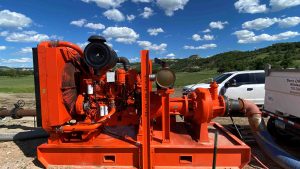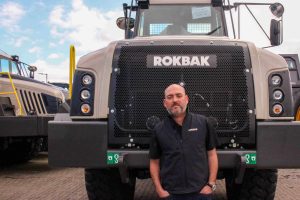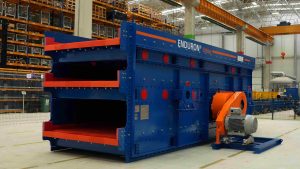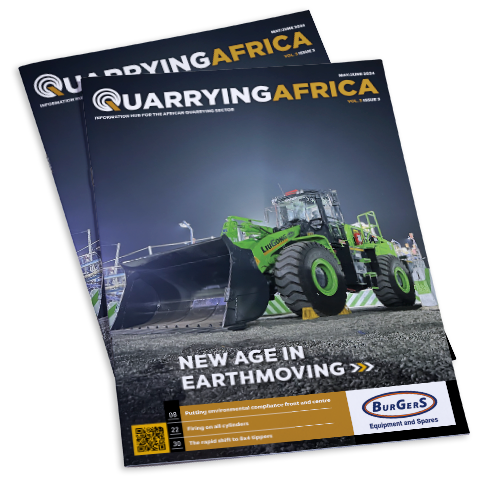The surface mining industry is an important contributor to the African economy. That the industry needs to explore newer technologies to maximise its potential is no overstatement. This is particularly the case in small-scale surface mining operations such as limestone quarries, where continuous surface mining technology has played a key role throughout the world in increasing production and reducing operational costs.
Traditional surface mining methods, says Beerthuis, have left untold tonnes of minerals underground, simply because there was no way to get to the detritus safely and efficiently. The Vermeer innovative Terrain Leveler surface excavation machines can work where explosives can’t, with top-down cutting that lets miners reach valuable deposits and get the most product out of the ground as possible.
“Other than the safety benefits stemming from the elimination of drill and blast (no explosives needed), less noise, reduction of dust, no nitrogen emissions into commodities and into ground water, there are significant operational efficiency benefits to the surface excavation machines as a consequence of the smaller and more uniform particle size distribution (PSD),” explains Beerthuis.
These benefits, he adds, include higher payloads on haul trucks (thus reducing haulage expense), reduced processing costs (mined product can bypass primary crushers for further processing), and higher throughput, through secondary crushers and processing lines.
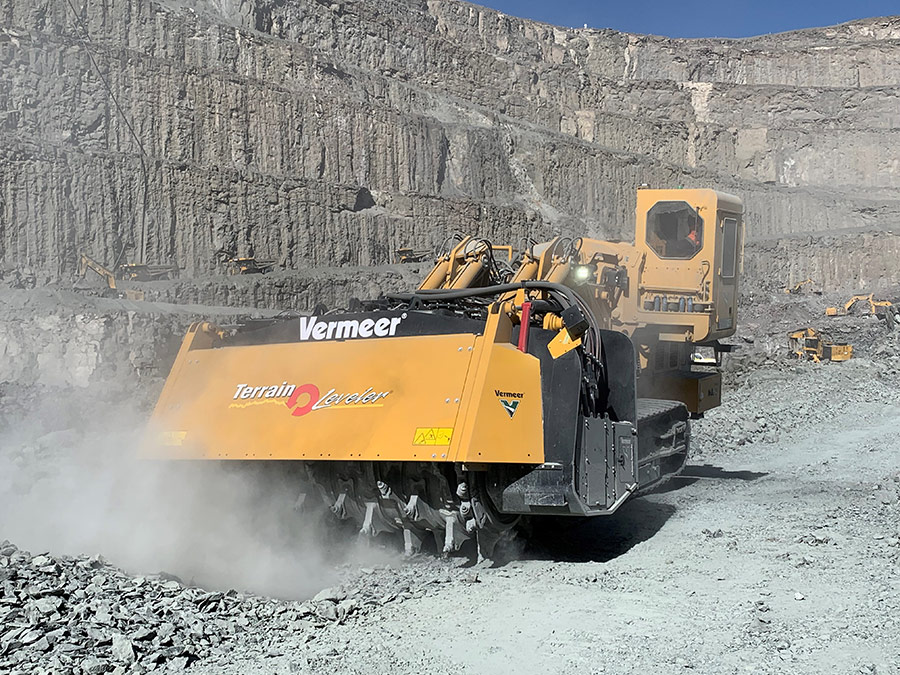
Key benefits
Vermeer continuous surface miners come with fully hydrostatic drives, thus doing away with traditional mechanical transmissions. The result is minimum energy loss between the cutter and the drum, thus increasing machine performance by up to 20% compared with mechanically driven counterparts.
The Vermeer T1255III surface excavation machine (SEM), for example, delivers enhanced production and efficiency. It has a fully hydrostatic motor mounted to the side of the cutting head, which provides direct drive power and delivers more horsepower to the cutting drum, resulting in enhanced efficiency when working in soft, medium or hard rock conditions.
The single-sided direct drive drum on the T1255III allows the operator to cut an 80° high wall to provide slope stability that is desirable in high-wall mining applications. The SmartTEC control software displays the status of critical elements of machine performance, alerting the operator to recommended control adjustment.
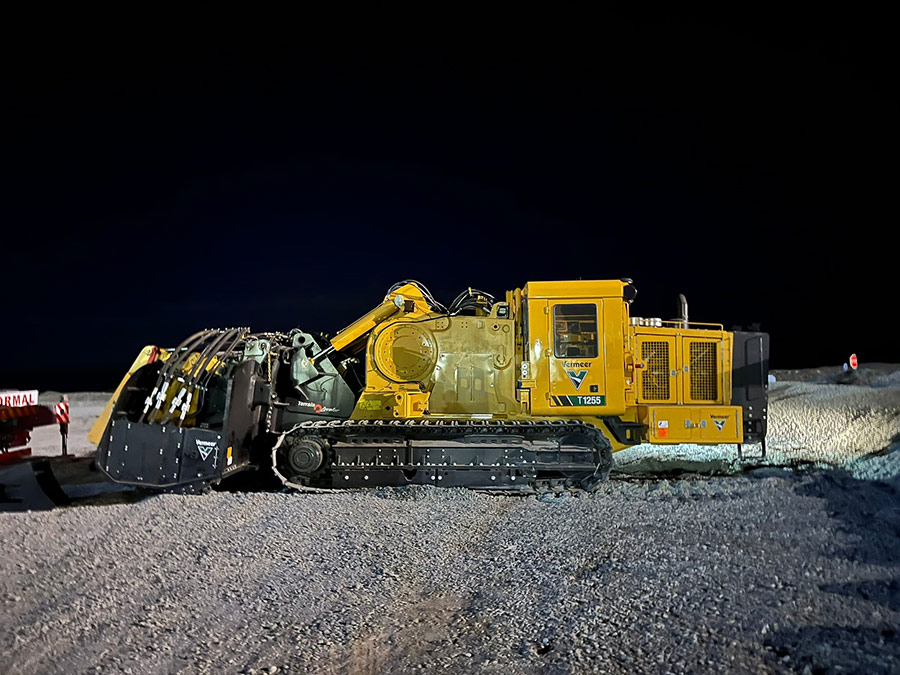
Success story
In a recent success story, Vermeer surface mining technology addressed the need for safer, more environment-friendly, effective and efficient mining for Letseng Diamond Mine in Lesotho. The mine conducted a trial to find an alternative technology that could result in reduced damage to the diamonds and ultimately recover higher value from them. Vermeer Equipment Suppliers’ T1255IIITL surface miner was used as part of a series of trials.
According to Jaco Houman, senior manager Technical and Projects at Gem Diamonds Technical Services, using a surface miner showed potential against the conventional drill and blast process which was followed by a primary crusher.
“The surface miner gives us the opportunity to effectively mine from the pit and produce a product that is similar to those two steps of drill and blast and primary crushing. From that perspective we are able to have a process that is potentially more cost-effective, and a process that is more complementary to the rest of our diamond processing flowsheet,” he says.
The trial took place from June 2022 to September 2022 and had the following outcomes: environmentally friendly; replacement of primary drill and blast as well as secondary pecking activities; more cost-effective on a cost-per-tonne basis; more stable processing due to greater consistency in product size distribution to the plant and more productivity and efficiency.
The trial period initially started on a single shift basis and then moved to a 24-hour basis. “The effective productivity that we had planned for in our overall works programme for the production period was around 66% effective in cutting time,” Houman says. “We exceeded that target with the deployment of the surface miner. He adds that the instantaneous cutting rate was within the expected target. “Overall productivity in the trial was certainly in line with our expectations.”
Although the machine was a new one on site, no mechanical issues were experienced, and production was not affected. “The machine performed very well mechanically,” says Houman. He adds that short-term challenges that did arise were easy to overcome, such as the inclusion of a dust suppression or dust extraction system in the full production unit.
The minor challenges encountered during the trial provided key considerations which could lead to increased efficiency when considered. They include mining/cutting through different geological domains with varying hardness, working on existing benches and in close proximity to bench crests, and mine planning, among others. “If you are putting this into a mine where you are starting from scratch, I think it is a lot easier putting a surface miner in there and reaping success earlier,” says Houman.
Features and technical support
The Vermeer T1255IIITL Single Side Direct Drive (SSDD) is powered by a CAT C18 Tier3 diesel engine. The mining drum on the machine has a cutting width of 3,7 m. Beerthuis explains that the unique features of the machine include the full hydrostatic direct drive of the mining drum which maximises the energy that is being transferred to the ground engaging tools (GETs) and thereby increases productivity. Another feature is the elimination of wear items in the driveline such as chains and sprockets, allowing for a significant reduction of operational expenditure.
“Another unique feature is the tilt function of the mining drum. This patented design feature allows for automated three-dimensional cutting of a smooth mining floor while cutting direction, cutting depth and slope angle are being controlled through GPS automation,” explains Beerthuis.
The machine also has a down-cut design which reduces the re-grind of mined rock. “As a result, clients will experience a more uniform PSD, reduced wear of GETs and higher production rates.”
Following three days of classroom training and a week of equipment operation with an instructor, the operators were deemed fit to run the equipment on their own. Vermeer Equipment Suppliers has been on site during the full period of the trial. Beerthuis explains that on two-week rotations, senior service technicians from Vermeer carried out the preventative maintenance of the machine and replacement of any worn items during the full period of the trial.
This trial showed that using the Vermeer T1255IIITL surface miner is a viable option for an open pit diamond mine. “The key factor for us is potentially generating more revenue per tonne and the fact that we further mitigate the risk of potential damage to our diamonds,” concludes Houman.

